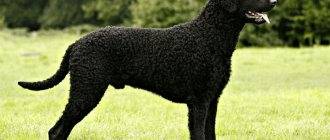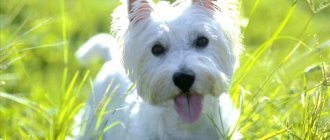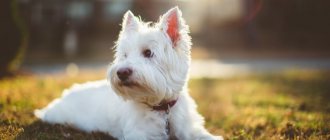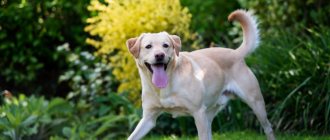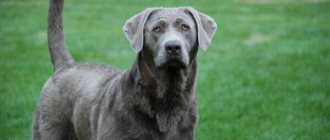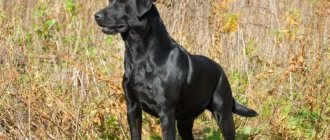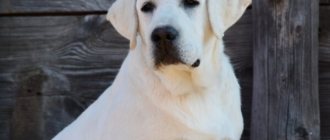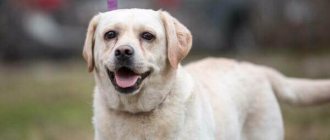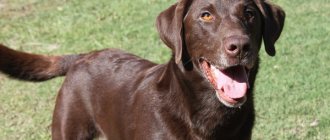Labrador Retrievers are gifted dogs with versatile skills and are used in the law enforcement agencies of countries, serving as guide dogs and being part of rescue teams around the world.
The word “retriever” is literally translated from English as “find and bring.”
A balanced psyche and unconditional love for people have become the hallmark of this breed, which began in the 1830s. laid by fishermen from St. John's, Fr. Newfoundland, who brought the ancestors of Labrador Retrievers to the UK.
Interesting Facts
During the existence of the breed, a lot of interesting things happened to it:
- It is believed that black Labradors are smarter than their fawn and chocolate counterparts. According to hunters, dark dogs are better at searching for shot game.
- According to one version, the breed was named after the blue-black rock labradorite.
- Black Labradors are capable of diving to a depth of 10 meters. Dogs of this breed can swim underwater for at least 20 m.
Expert opinion
Leonid Rodin
Experienced dog breeder
Ask a Question
In 1925, news spread across America about a black Labrador who had been imprisoned for 10 years without parole. He allegedly ate the cat of the wife of the governor of Pennsylvania and was convicted for this crime. Only a few years later, Cornelia Pinchot, the governor’s wife, dispelled this myth. It turns out that the family had been breeding Labradors for many years. But when there were too many dogs, they began to be distributed to various institutions: shelters, nursing homes, and children's institutions. And a Labrador named Pep was given to a local prison so that he would brighten up the monotonous everyday life of prisoners and guards. There the journalists saw this dog, making up a heartbreaking story on the spot. Interestingly, Pep the Labrador later moved to another correctional facility, where he continued to have close contact with convicts. It is unknown how many prisons he changed in his lifetime. But when he died, he was buried next to other prisoners in the local cemetery.
Feeding Labradors
An adult dog needs to be fed twice a day. Basically, dogs are fed meat, fish, porridge, milk and vegetable mixtures. Formulas are usually given in the morning, and meat products in the evening.
The serving size is determined individually. To do this, you need to watch the dog during feeding and decide whether it eats its portion or not.
Nutrition should be balanced and complete. It is prohibited to give sweet and salty foods to Labradors, including various sausages and sausages. You can buy ready-made dry or wet food and give it to your dog.
Breed description, standards and appearance
The Labrador Retriever is a compact, strong, medium-sized dog with well-developed muscles. The characteristics that a typical representative of this breed must meet are collected in the FCI standard (as of January 2011):
- The head is proportional, not too massive, but not thin-boned either. The skull is wide with a pronounced stop.
- The jaws are strong and moderately long. Scissor bite. White teeth, complete.
- The nose is wide, well pigmented with prominent nostrils.
- Eyes of medium size. The look is lively and intelligent. Eye color is brown or hazel.
- The ears are set far back, small, hanging.
- The body is compact with a straight topline. The neck is powerful and strong. The chest is wide, deep with arched ribs. The loin is strong and short.
- The limbs are straight with developed muscles. The feet are round, compact, with hard pads and webbed toes.
- The tail is of medium length, thick at the base, gradually tapering. It has a characteristic “otter” shape. The purebred Labrador Retriever never curls its tail over its back.
| Height, cm | Weight, kg | |
| Male | 56-57 | 28-36 |
| Female | 54-56 | 24-32 |
The movements of black retrievers are free and productive.
Labrador color and coat type
Representatives of this breed have a warm “fur coat”, which they inherited from their ancestors who lived in harsh climatic conditions.
Both light and dark Labrador retrievers have a water-repellent, coarse coat, without waves or feathering. Under the short, shiny coat of the retriever there is a developed undercoat.
Labrador is not only black. The standard allows for the existence of several color options. According to him, in addition to coal labs, there are also chocolate and fawn dogs.
The shades of wool can be varied. The most common colors are liver, golden and light cream, almost white labradorite. Black Labrador Retrievers are allowed a small white patch on their chest.
Coat color
The coat is hard, water-repellent, without frays or waves, with a dense undercoat.
There are black and fawn Labradors, chocolate and golden. Representatives of dark shades may have a white spot on their chest. For reference! Black and white color is very rare and is considered outside the standard.
Such dogs do not participate in exhibitions. But that doesn't make them any less attractive. Labradors are always short-haired, with a dark coat color. They are often confused with golden retrievers, which are lighter in color and can have long hair.
Labradors are always dark in color and have short hair.
Character and behavior
The black Labrador is an obedient, devoted, passionate, efficient and completely non-aggressive dog. He is able to make decisions with lightning speed, for which hunters especially value him.
The black Labrador retriever has a stable psyche and quickly becomes attached to its owners. The dog does not like to be left alone for a long time and begins to feel sad.
The Labrador Retriever has a friendly and loving nature. He is good with children and gets along well with cats. Black Labradors are very difficult to unbalance and force to attack a person. But if necessary, the dog can stand up for its own.
On a note. Black Labrador Retrievers do not single out just one owner. They treat every family member with equal respect and love.
Purpose
According to sources, dogs used to help fishermen get nets out of the water. They are really very strong and can swim. Now they are used to help disabled people as guide dogs. Labradors are excellent detectives and rescuers. Security qualities are weakly expressed, because the animals are very friendly. If a stranger wants to play with a pet, he will only be happy.
Caring for puppies
Labrador puppies require a lot of attention. From the first days they need to be accustomed to a certain regime and to a diaper.
Once the little Labrador Retriever has received all his vaccinations, he is taken outside and taught to relieve himself outside the house.
The puppy is fed approximately the same foods as adult black Labradors. Only small Labrador Retrievers are given food in small portions at regular intervals.
The number of feedings depends on the age of the puppy:
- 1-2 months – 6 times a day;
- 2-3 months – 5 times a day;
- 4-5 months – 4 times a day;
- 6-10 months – 3 times a day.
In the future, the black Labrador is transferred to two meals a day.
Price range
Prices for black Labradors with a properly issued puppy card vary around 40-60 thousand rubles.
NOTE!
Despite the fact that Labrador puppies are in high demand, there are enough Labrador kennels in Russia, the competition between them is high, so you can try to bargain with the breeder and get a small discount.
Care and maintenance of an adult dog
The Black Labrador Retriever is an unpretentious dog that easily adapts to different conditions. It can be kept in a spacious enclosure with an insulated booth, or in a city apartment.
Care at home comes down to regular walking, proper nutrition and basic hygiene procedures.
The right diet
Owners who do not have time to prepare food for their pets will prefer to feed black Labradors with dry food. This type of food will provide the dog with the entire range of necessary vitamins and microelements.
The best brands for Labrador Retrievers are ProPlan, Royal Canin, Acana, and Josera.
Those who prefer to feed their black Labradors natural food need to remember that the dog’s diet should contain the following products:
- raw meat (beef, turkey, lean lamb or chicken breast);
- offal (liver, heart, kidneys and tripe);
- vegetables (zucchini, carrots, pumpkin and beets);
- cereals (rice, buckwheat and oatmeal);
- sour milk (cottage cheese and kefir);
- sea fish;
- eggs.
It is strictly forbidden to feed a black Labrador with pasta, baked goods, sausages, sweets, tubular bones, potatoes, onions, smoked meats, pork and leftovers from the master's table.
Important! The Black Labrador Retriever is a big eater. If he is not limited in food, the dog will quickly gain excess weight, and this is fraught with health problems.
Walking and physical activity
The black Labrador is an active and lively dog that needs long periods of time in the fresh air. They walk with him in any weather for at least 1.5-2 hours a day.
While you are outside with your dog, you can not only calmly wander along the alleys, but also run, play active games and practice learned commands.
If possible, the black Labrador retriever is taken to the pond for a swim.
Training and education
Labradors are very smart dogs. They are endowed with a lively mind and excellent memory. Even a beginner who has no experience in raising dogs can teach a black Labrador retriever basic commands.
To prevent the puppy from losing interest in classes, the first lessons are conducted in a playful way and make sure that they last no longer than 5-10 minutes. During the training process, the black Labrador must be rewarded with treats and verbal praise.
In order for an adult dog to respond adequately to stimuli, the dog is taught from an early age to be calm towards strangers, different types of transport and loud sounds.
Care and hygiene
To ensure that black Labradors always have a neat and presentable appearance, their fur is regularly combed with a special brush or mitten. In normal times, this is done a couple of times a week, and during the molting period every day.
Although the Black Labrador loves to bathe, it is not advisable to wash it with shampoo frequently. Bath procedures are carried out no more than once a month. And after washing, the dog is rinsed with clean water, dried with a towel and dried with a hairdryer.
The Labrador's floppy ears are regularly cleaned with a cotton pad soaked in a special lotion. If this is not done, the risk of developing otitis media and other ear diseases increases.
The eyes of a black Labrador retriever are wiped daily with a swab, which has been previously dipped in boiled water or chamomile infusion.
A dog's nails usually wear down naturally. But if necessary, they are trimmed with a nail clipper.
Nutrition
Types of food are divided into 2 types: dry coma and natural food.
Breeders recommend feeding Labradors with premium ready-made dry food. Such products are fully balanced, adapted to the breed and its physical activity, do not require time-consuming preparation, and contain minerals, trace elements and vitamins in the required proportions.
Natural nutrition is characterized by difficulty in creating a diet and selecting foods acceptable for animal consumption. The main part of the diet should consist of lean meats, vegetable fats, vegetables and offal. The Labrador's menu should include fish, eggs, cottage cheese, kefir and porridge.
It is prohibited to give:
- flour;
- roast;
- tubular bones;
- sweets;
- spices;
- pickles;
- grape;
- pasta;
- food from the owner's table;
Important! Labradors tend to be overweight, and a fat dog is sedentary and susceptible to various diseases. Therefore, you should absolutely not overfeed them.
Vaccinations and susceptibility to disease
To prevent a black Labrador from catching the virus, he must be vaccinated. The vaccination is given only to a healthy dog that has been previously treated against fleas and helminths.
The first vaccination is given to a puppy at the age of 8-9 weeks. After 21 days, the drug is re-administered. Subsequently, the dog is vaccinated annually using a complex drug that protects:
- from canine plague;
- leptospirosis;
- parainfluenza;
- viral hepatitis;
- enteritis;
- rabies.
Black Labrador Retrievers are in good health and, with proper care, will live for about 10-12 years.
But dogs of this breed are predisposed to the following diseases:
- dysplasia of the elbow and hip joints;
- obesity;
- atopic dermatitis;
- osteochondrosis;
- cataract.
What needs to be done before the puppy comes home?
Before a significant event, it is necessary to hide things that a small dog can swallow. All wires should be covered, and extension cords and antennas should be hidden.
Carpeting or rubber tracks should be installed on tiled floors, parquet and laminate.
It is worth preparing all the necessary items in advance (bowls, combs, toys, leashes and collar, sleeping bag). This way, you will have all the necessary elements for a Labrador puppy to live a comfortable life with you.
Pros and cons of the breed
| Advantages | Flaws |
| High intelligence | Tendency to obesity |
| Lack of aggression | Need for long walks |
| Ability to get along with children | Relatively large sizes |
| Attachment to owners |
Black Labradors are cheerful, active and lively dogs that retain their puppy-like spontaneity into old age.
They are highly intelligent and amenable to training.
Thanks to their outstanding mental abilities and complete lack of aggression, dogs of this breed make excellent companions, rescuers, canine therapists and hunters.
Popular nicknames
Many dog breeders name their pets based on their color.
Below are the most popular names for black Labradors:
- for a black boy : Hades, Bruno, Black, Blade, Bond, Boomer, Woland, Dark, Diesel, Moor, Neo, Nero, Noir, Onyx, Richie, Romeo, Swart, Sirius, Charlie;
- for a black girl : Bagheera, Bonnie, Bertha, Blackie, Verona, Vendetta, Karma, Lara, Infinity, Audrey, Panther, Tiara, Shadow.
Of course, the list is not limited to these names for boys and girls. Each owner decides for himself what to name his pet. The main thing to remember here is that the nickname suits the animal.
Grooming
Labradors are quite unpretentious and do not require special care. Their fur does not tangle and does not require frequent brushing. Natural lubrication gives it water- and dirt-repellent properties. It is impossible to say that the dog will not get dirty at all, but there will be no difficulties in washing it. In most cases, it is enough to wipe your pet with a damp towel. Frequently washing an animal with shampoo is not recommended at all, so as not to disturb the natural protective layer, unless it is soiled with something strongly “fragrant”.
Healthy dogs shed profusely 2 times a year, when the coat changes before the new climatic season: autumn and spring. There are ways to speed up this process, for example using a special comb - a furminator, but it is impossible to get rid of it completely. If a Labrador sheds all year round, then most likely this indicates disturbances in the animal’s nutrition.
Nails need to be trimmed as needed, but more often they wear down on hard surfaces during a walk, except for the dewclaws. The dog's ears and eyes should be clean and free of foreign odors. The presence of discharge may indicate errors in nutrition or the presence, for example, of a fungal infection, which is the task of a veterinarian to determine.
